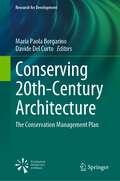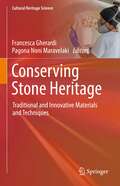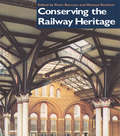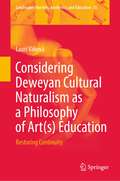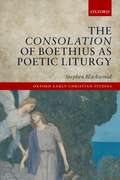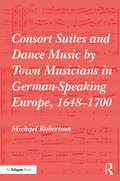- Table View
- List View
Conservation of Leather and Related Materials
by Marion Kite Roy ThomsonThe conservation of skin, leather and related materials is an area that, until now, has had little representation by the written word in book form. Marion Kite and Roy Thomson, of the Leather Conservation Centre, have prepared a text which is both authoritative and comprehensive, including contributions from the leading specialists in their fields, such as Betty Haines, Mary Lou Florian, Ester Cameron and Jim Spriggs.The book covers all aspects of Skin and Leather preservation, from Cuir Bouillie to Bookbindings. There is significant discussion of the technical and chemical elements necessary in conservation, meaning that professional conservators will find the book a vital part of their collection. As part of the Butterworth-Heinemann Black series, the book carries the stamp of approval of the leading figures in the world of Conservation and Museology, and as such it is the only publication available on the topic carrying this immediate mark of authority.
Conservation of Leather and Related Materials
by Marion Kite Roy ThomsonThe conservation of skin, leather and related materials is an area that, until now, has had little representation by the written word in book form. Marion Kite and Roy Thomson, of the Leather Conservation Centre, have prepared a text which is both authoritative and comprehensive, including contributions from the leading specialists in their fields, such as Betty Haines, Mary Lou Florian, Ester Cameron and Jim Spriggs.The book covers all aspects of Skin and Leather preservation, from Cuir Bouillie to Bookbindings. There is significant discussion of the technical and chemical elements necessary in conservation, meaning that professional conservators will find the book a vital part of their collection. As part of the Butterworth-Heinemann Black series, the book carries the stamp of approval of the leading figures in the world of Conservation and Museology, and as such it is the only publication available on the topic carrying this immediate mark of authority.
Conservation of Plastics
by Yvonne ShashouaPlastic objects are included more than ever in museums and galleries collections these days, but these items can start to deteriorate when they a just a few years old. In this book Yvonne Shashoua provides the essential knowledge needed to keep plastic pieces in the best possible condition so that they can continue to be enjoyed for many years. The historical development of plastics, as well as the technology, their physical and chemical properties, identification, degradation and conservation are all clearly and concisely covered within this single volume, making it an invaluable reference for the increasing number of conservators and curators that are encountering plastics in their day to day work.
Conservation of Plastics
by Yvonne ShashouaPlastic objects are included more than ever in museums and galleries collections these days, but these items can start to deteriorate when they a just a few years old. In this book Yvonne Shashoua provides the essential knowledge needed to keep plastic pieces in the best possible condition so that they can continue to be enjoyed for many years. The historical development of plastics, as well as the technology, their physical and chemical properties, identification, degradation and conservation are all clearly and concisely covered within this single volume, making it an invaluable reference for the increasing number of conservators and curators that are encountering plastics in their day to day work.
Conservation of Ruins
by John AshurstDespite growing international awareness of the presence and significance of ruined buildings and archaeological sites, and the increasingly sophisticated technology available for the collection of data about them, these sites continue to be at risk across the globe. Conservation of Ruins defines and describes these risks, which range from neglect, to destructive archaeology, and even well-meaning intervention in the name of tourism. The book provides detailed, practical instruction on the conservation and stabilisation of ruins by structural and non-structural means, as well as describing the procedures and conditions that need to be in place to ensure the protection of our important historic sites. In considering aspects of architectural conservation, archaeology and ecology together for the first time, this book provides an integrated, holistic view of this international topic that will be essential reading for those working in this field
Conservation of Ruins
by John AshurstDespite growing international awareness of the presence and significance of ruined buildings and archaeological sites, and the increasingly sophisticated technology available for the collection of data about them, these sites continue to be at risk across the globe. Conservation of Ruins defines and describes these risks, which range from neglect, to destructive archaeology, and even well-meaning intervention in the name of tourism. The book provides detailed, practical instruction on the conservation and stabilisation of ruins by structural and non-structural means, as well as describing the procedures and conditions that need to be in place to ensure the protection of our important historic sites. In considering aspects of architectural conservation, archaeology and ecology together for the first time, this book provides an integrated, holistic view of this international topic that will be essential reading for those working in this field
Conservation of Time-Based Media Art (Routledge Series in Conservation and Museology)
by Deena Engel Joanna PhillipsConservation of Time-based Media Art is the first book to take stock of the current practices and conceptual frameworks that define the emerging field of time-based media conservation, which focuses on contemporary artworks that contain video, audio, film, slides or software components. Written and compiled by a diverse group of time-based media practitioners around the world, including conservators, curators, registrars and technicians among others, this volume offers a comprehensive survey of specialized practices that have developed around the collection, preservation and display of time-based media art. Divided into 23 chapters with contributions from 36 authors and 85 additional voices, the narrative of this book provides both an overview and detailed guidance on critical topics, including the acquisition, examination, documentation and installation of time-based media art; cross-medium and medium-specific treatment approaches and methods; the registration, storage, and management of digital and physical artwork components; collection surveys and project advocacy; lab infrastructures, staffing and the institutional implementation of time-based media conservation. Conservation of Time-based Media Art serves as a critical resource for conservation students and for a diverse professional audience who engage with time-based media art, including conservation practitioners and other collection caretakers, curators, art historians, collectors, gallerists, artists, scholars and academics.
Conservation of Time-Based Media Art (Routledge Series in Conservation and Museology)
by Deena Engel Joanna PhillipsConservation of Time-based Media Art is the first book to take stock of the current practices and conceptual frameworks that define the emerging field of time-based media conservation, which focuses on contemporary artworks that contain video, audio, film, slides or software components. Written and compiled by a diverse group of time-based media practitioners around the world, including conservators, curators, registrars and technicians among others, this volume offers a comprehensive survey of specialized practices that have developed around the collection, preservation and display of time-based media art. Divided into 23 chapters with contributions from 36 authors and 85 additional voices, the narrative of this book provides both an overview and detailed guidance on critical topics, including the acquisition, examination, documentation and installation of time-based media art; cross-medium and medium-specific treatment approaches and methods; the registration, storage, and management of digital and physical artwork components; collection surveys and project advocacy; lab infrastructures, staffing and the institutional implementation of time-based media conservation. Conservation of Time-based Media Art serves as a critical resource for conservation students and for a diverse professional audience who engage with time-based media art, including conservation practitioners and other collection caretakers, curators, art historians, collectors, gallerists, artists, scholars and academics.
Conservation Skills for the 21st Century: Judgement, Method, and Decision-Making
by Chris Caple Emily WilliamsConservation Skills for the 21st Century provides a much-needed update to the original Conservation Skills volume, presenting an overview of current issues facing conservators of historic and artistic works. Beginning with the basics – why the past is important, as well as an overview of the nature and history of conservation – the book allows the reader to develop a holistic appreciation of the subject. As with the first edition, this volume assists with the development of judgement in conservation students and young professionals. A selection of new case studies representing issues conservators are likely to face in the 21st century illustrates the crucial considerations that must be made when proposing and executing a conservation treatment. Incorporating recent developments and use of new technologies in conservation processes, the book also covers topics such as conservation ethics; recording and documentation; investigating and cleaning objects; stabilisation and restoration; values, decision-making, and responsibilities; preventive conservation; approaches to the treatment of working and socially active objects; sustainability in conservation; and the conservator’s role as advocate. With detailed case studies and written in a clear, accessible style, Conservation Skills for the 21st Century remains essential reading for student conservators and conservation professionals around the globe working across a wide range of conservation disciplines.
Conservation Skills for the 21st Century: Judgement, Method, and Decision-Making
by Chris Caple Emily WilliamsConservation Skills for the 21st Century provides a much-needed update to the original Conservation Skills volume, presenting an overview of current issues facing conservators of historic and artistic works. Beginning with the basics – why the past is important, as well as an overview of the nature and history of conservation – the book allows the reader to develop a holistic appreciation of the subject. As with the first edition, this volume assists with the development of judgement in conservation students and young professionals. A selection of new case studies representing issues conservators are likely to face in the 21st century illustrates the crucial considerations that must be made when proposing and executing a conservation treatment. Incorporating recent developments and use of new technologies in conservation processes, the book also covers topics such as conservation ethics; recording and documentation; investigating and cleaning objects; stabilisation and restoration; values, decision-making, and responsibilities; preventive conservation; approaches to the treatment of working and socially active objects; sustainability in conservation; and the conservator’s role as advocate. With detailed case studies and written in a clear, accessible style, Conservation Skills for the 21st Century remains essential reading for student conservators and conservation professionals around the globe working across a wide range of conservation disciplines.
Conservative thinkers: The key contributors to the political thought of the modern Conservative Party
by Mark Garnett Kevin HicksonThis book outlines and evaluates the political thought of the Conservative Party through a detailed examination of its principal thinkers from Harold Macmillan to the present. Traditionally, the Conservative Party has been regarded as a vote-gathering machine rather than a vehicle for ideas. This book redresses the balance through a series of biographical essays examining the thought of those who have contributed most to the development of ideas within the party. The chapters benefit from archival research and interviews with leading Conservatives. The recent revival of Conservative fortunes makes the book particularly timely. The book begins with an introductory chapter explaining the role of ideology in the Conservative Party. It then traces the political thought of the Conservative Party through its principal theorists since the 1930s. These are Harold Macmillan, R. A. Butler, Quintin Hogg, Enoch Powell, Angus Maude, Keith Joseph, the ‘traditionalists’ (Maurice Cowling, T. E. ‘Peter’ Utley, Peregrine Worsthorne, Shirley Letwin and Roger Scruton), Ian Gilmour, John Redwood and David Willetts. The book concludes with an overall assessment of the political thought of the Conservative Party and the relevance of past debates for contemporary Conservatism. The book will be of considerable interest to academics and non-academics alike; for those who have a special interest in the Conservative Party but also for any student of contemporary British Politics.
Conserving 20th-Century Architecture: The Conservation Management Plan (Research for Development)
by Maria Paola Borgarino Davide Del CurtoThis book offers an international overview of how to apply the Conservation Management Plan (CMP) to the 20th-century architectural heritage. Although the CMP is universally considered a fundamental tool for sustainable management of the built heritage, the application to 20th-century buildings is still limited. The book illustrates selected case studies from different countries to discuss how best to preserve the authenticity of the original materials, manage changes in use, engage users and stakeholders in this process, and make conservation and sustainability work together. "Conserving 20th-century architecture" will provide insights for scholars and students and assist architects in drafting an effective conservation management plan.
Conserving Stone Heritage: Traditional and Innovative Materials and Techniques (Cultural Heritage Science)
by Francesca Gherardi Pagona Noni MaravelakiThe design of treatments for the conservation of stone in historical buildings and works of art is a challenging task, as a deep understanding of the working properties and performance of the available products and methods is required to tackle complex decay patterns.The chapters in this book illustrate the state of the art on traditional and innovative materials and methods for stone conservation, examining current trends and future perspectives. Each of them is focused on describing the consequent phases that complement the spectrum of the conservation intervention: preliminary investigations, condition assessment, and mapping of the deterioration patterns; surface cleaning, with a specific focus on laser technology; consolidation; protection; repair mortars and grouts; and onsite assessment and monitoring of conservation treatments. The performance of the applied conservation interventions is criticized and discussed with an aim of providing the specialists with specific tools for stone conservation. This book intends to bridge the gap between laboratory studies and conservation interventions, by linking together the diverse scientific areas involved in the preservation of stone heritage. Different case studies are included, highlighting specific conservation challenges and their solutions in order to understand and overcome them. The aim is to guide conservators, conservation scientists and heritage stakeholders in the selection of compatible and sustainable materials and techniques for Conserving Stone Heritage.
Conserving the Railway Heritage
by Peter Burman Michael StrattonGreat Britain not only invented the main-line railway but has also led the way in it's preservation - not just locomotves and carriages but also the buildings and structures that bear witness to the confidence of railway developers, architects and engineers. This book defines the nature of the railway heritage - from signalboxes, viaducts, tunnels and locomotive depots - and then discusses priorities and the best practice for it's conservation. The subject is a strongly topical one due to current concern over privatization, the effects of planned high-speed rail links and lively debates concerning the role of the enthusiast in railway preservation.
Conserving the Railway Heritage
by Peter Burman Michael StrattonGreat Britain not only invented the main-line railway but has also led the way in it's preservation - not just locomotves and carriages but also the buildings and structures that bear witness to the confidence of railway developers, architects and engineers. This book defines the nature of the railway heritage - from signalboxes, viaducts, tunnels and locomotive depots - and then discusses priorities and the best practice for it's conservation. The subject is a strongly topical one due to current concern over privatization, the effects of planned high-speed rail links and lively debates concerning the role of the enthusiast in railway preservation.
Considering Deweyan Cultural Naturalism as a Philosophy of Art: Restoring Continuity (Landscapes: the Arts, Aesthetics, and Education #35)
by Lauri VäkeväThis book makes a case for cultural naturalism as a basis for a philosophy of art education. It argues for a holistic approach that avoids hard boundaries between artistic disciplines in the educational context, applying cultural naturalism to challenges that are topical for the whole art(s) education field, including challenges related to ecology, social justice, and technological transformation of culture. The book is written in the form of a conditional argument that considers the consequences of cultural naturalism for today’s philosophical problem-solving in art(s) education. It contains a systematic and historical analysis of cultural naturalism that support the philosophical reflection of educators and other scholars operative in this field. The result is a late modern reading of Deweyan cultural naturalism that highlights the continuance of key philosophical ideas from the modern to present discourses. The key topics discussed are of particular interest to present-day art(s) educators: ecological sustainability, social justice, and technological transformation of culture. In addition, this book provides an example of pragmatist argumentation, suggesting an alternative to analytical and post-philosophical approaches.
Considering Ethics in Dance, Theatre and Performance
by Fiona BannonThis book asks important questions about making performance through the means of collaboration and co-created practice. It argues that we can align ethics and aesthetics with collaborative performance to realise the importance of being in association with one another, and being engaged through our shared imaginations. Evident in the examples of practice visited in this study is the attention given by a number of practitioners to the development of shared, co-operative modes of creation. Here, we can appreciate ethical work as being relational, forged in association with the others as we cultivate ideas that matter.In looking at a range of work from practitioners including Meg Stuart, Rosemary Lee, Deufert&Philschke and Fevered Sleep, Considering Ethics in Dance, Theatre and Performance explores ways that we rehearse by attending to ethics, aesthetics and co-creation. In learning to listen, to observe, to co-operate and to negotiate, these practitioners reveal the ways that they bring their work into existence through the transmission of shared meaning.
Considering Ethics in Dance, Theatre and Performance
by Fiona BannonThis book asks important questions about making performance through the means of collaboration and co-created practice. It argues that we can align ethics and aesthetics with collaborative performance to realise the importance of being in association with one another, and being engaged through our shared imaginations. Evident in the examples of practice visited in this study is the attention given by a number of practitioners to the development of shared, co-operative modes of creation. Here, we can appreciate ethical work as being relational, forged in association with the others as we cultivate ideas that matter.In looking at a range of work from practitioners including Meg Stuart, Rosemary Lee, Deufert&Philschke and Fevered Sleep, Considering Ethics in Dance, Theatre and Performance explores ways that we rehearse by attending to ethics, aesthetics and co-creation. In learning to listen, to observe, to co-operate and to negotiate, these practitioners reveal the ways that they bring their work into existence through the transmission of shared meaning.
The Consolation of Boethius as Poetic Liturgy (Oxford Early Christian Studies)
by Stephen BlackwoodThroughout Antiquity and the Middle Ages, literature was read with the ear as much as with the eye: silent reading was the exception; audible reading, the norm. This highly original book shows that Boethius's Consolation of Philosophy - one of the most widely-read texts in Western history-aims to affect the listener through the designs of its rhythmic sound. Stephen Blackwood argues that the Consolation's metres are arranged in patterns that have a therapeutic and liturgical purpose: as a bodily mediation of the text's consolation, these rhythmic patterns enable the listener to discern the eternal in the motion of time. The Consolation of Boethius as Poetic Liturgy vividly explores how in this acoustic encounter with the text philosophy becomes a lived reality, and reading a kind of prayer.
The Console Chronicles
by Lost in CultThe Console Chronicles will take you on a unique journey through the history of gaming platforms. Fifty years ago, the home console was an anomaly that predated when everyone around the world knew the name Nintendo. With each passing generation, consoles evolved, their pixels exchanged for polygons. Over time, these machines gained popularity and brought the beginnings of a new artistic frontier. Consoles enabled split-screen chaos, late-night LAN parties, and interlinked online play – connecting friendships worldwide. The Console Chronicles is the ultimate tribute to not only five decades of home console gaming, but to the incredible people, and their remarkable stories, which make our shared history special. Telling tales of sibling rivalries and disruptive ideas, personal resonance and technical triumph, this is a celebration of every system that you hold dear. Words and art by: Christian Donlan Ashley Esqueda Julian Rignall Damien McFerran Sara Heritage Alex Olney Alana Hagues Mer Grazzini Dan Adelman Alicia Haddick Stephen Maurice Graham Adam Koralik Raul Higuera Brendan Hesse Suhaila Karim Plus many more! Made in collaboration with Hookshot Media. This edition published in partnership with Expanse, an imprint of HarperCollinsPublishers.
Consort Suites and Dance Music by Town Musicians in German-Speaking Europe, 1648–1700
by Michael RobertsonThis companion volume to The Courtly Consort Suite in German-Speaking Europe surveys an area of music neglected by modern scholars: the consort suites and dance music by musicians working in the seventeenth-century German towns. Conditions of work in the German towns are examined in detail, as are the problems posed by the many untrained travelling players who were often little more than beggars. The central part of the book explores the organisation, content and assembly of town suites into carefully ordered printed collections, which refutes the concept of the so-called 'classical' suite. The differences between court and town suites are dealt with alongside the often-ignored variation suite from the later decades of the seventeenth century and the separate suite-writing traditions of Leipzig and Hamburg. While the seventeenth-century keyboard suite has received a good deal of attention from modern scholars, its often symbiotic relationship with the consort suite has been ignored. This book aims to redress the balance and to deal with one very important but often ignored aspect of seventeenth-century notation: the use of blackened notes, which are rarely notated in a meaningful way in modern editions, with important implications for performance.
Consort Suites and Dance Music by Town Musicians in German-Speaking Europe, 1648–1700
by Michael RobertsonThis companion volume to The Courtly Consort Suite in German-Speaking Europe surveys an area of music neglected by modern scholars: the consort suites and dance music by musicians working in the seventeenth-century German towns. Conditions of work in the German towns are examined in detail, as are the problems posed by the many untrained travelling players who were often little more than beggars. The central part of the book explores the organisation, content and assembly of town suites into carefully ordered printed collections, which refutes the concept of the so-called 'classical' suite. The differences between court and town suites are dealt with alongside the often-ignored variation suite from the later decades of the seventeenth century and the separate suite-writing traditions of Leipzig and Hamburg. While the seventeenth-century keyboard suite has received a good deal of attention from modern scholars, its often symbiotic relationship with the consort suite has been ignored. This book aims to redress the balance and to deal with one very important but often ignored aspect of seventeenth-century notation: the use of blackened notes, which are rarely notated in a meaningful way in modern editions, with important implications for performance.
Conspiracy Ideologies in Films and Series: Explanatory Approaches and Opportunities for Intervention
by Denis Newiak Anastasia SchnitzerCorona as a staged instrument of oppression, secretly kept vaccination deaths or politicians drinking children's blood: at the latest since the outbreak of the Covid 19 pandemic, conspiracy ideologies are booming and harm social peace and democratic will formation through their dogmatism. So-called conspiracy theories generate systematic distrust of legitimate political institutions and can contribute to social polarization, dangerous populism and extremist escalation. Conspiracy ideologies have always been a topic in movies and television series, as they have always dealt with the relationship between reality and illusion, truth and fiction, reality and dream, sense and madness through their cinematic means. Series and films not only serve as a discursive space for social self-understanding, but also, through their complex narratives, constellations of characters and aesthetics, offer catchy explanations for the emergence and spread of conspiracy narratives. At the same time, theymake suggestions, some of them astonishingly concrete, for dealing with such collective delusions. What can we learn from the fictional worlds of series and films for dealing with this very real contemporary phenomenon?
Conspiracy in Modern Egyptian Literature
by Benjamin KoerberFirst ever book-length study of Scotland’s immigrant communities since 1945
Conspiracy in Modern Egyptian Literature (Edinburgh Studies In Modern Arabic Literature Ser.)
by Benjamin KoerberContextualises current Salafi iconoclasm and graves destruction, tracing its ideological sources






